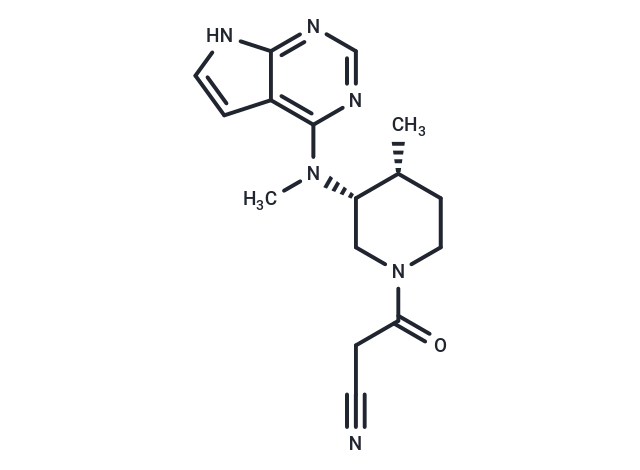Shopping Cart
- Remove All
 Your shopping cart is currently empty
Your shopping cart is currently empty

Tofacitinib (Tasocitinib) is a Janus kinase inhibitor that inhibits JAK3/2/1 (IC50=1/20/112 nM) and is orally active. Tofacitinib is used for the treatment of moderate to severe rheumatoid arthritis.

| Pack Size | Price | Availability | Quantity |
|---|---|---|---|
| 5 mg | $30 | In Stock | |
| 10 mg | $47 | In Stock | |
| 25 mg | $59 | In Stock | |
| 50 mg | $77 | In Stock | |
| 100 mg | $98 | In Stock | |
| 200 mg | $147 | In Stock | |
| 500 mg | $275 | In Stock |
| Description | Tofacitinib (Tasocitinib) is a Janus kinase inhibitor that inhibits JAK3/2/1 (IC50=1/20/112 nM) and is orally active. Tofacitinib is used for the treatment of moderate to severe rheumatoid arthritis. |
| Targets&IC50 | JAK2:20 nM, JAK1:112 nM, JAK3:1 nM |
| In vitro | METHODS: The human MM cell line MM.1S was co-cultured with the immortalized BMSC lines HS5 and HS27A and treated with Tofacitinib (0-10 µM) for 24 h. Cell viability was measured by CellTiter-Glo reagent. RESULTS: A significant increase in MM.1S cell number was observed compared to monoculture growth, confirming the stroma-induced proliferative signaling in this cell line.Tofacitinib treatment reduced MM.1S cell number in a dose-dependent manner.Tofacitinib alone had no effect on MM.1S cell viability or on stromal cells alone. [1] METHODS: NK-92 cells were treated with Tofacitinib (50 nM) overnight and IL-15 (2.33 nM) for 2 h. STAT1 phosphorylation was measured. RESULTS: Tofacitinib blocked IL-15 signaling in NK-92 cells. tofacitinib disrupted JAK/STAT signaling by blocking STAT protein phosphorylation. [2] |
| In vivo | METHODS: To detect anti-tumor activity in vivo, NSG mice bearing in situ-diffused MM.1S xenografts were injected subcutaneously with Tofacitinib (21.5 mg/kg, 50% DMSO+10% PEG 400+40% water) once daily for four weeks. RESULTS: Mouse survival was significantly improved and tumor load was significantly reduced based on bioluminescence imaging quantification. [1] |
| Kinase Assay | JAK3 Kinase Assay: A fragment encoding the catalytic domain of human JAK3 (785aa to 1125aa, JH1 catalytic domain) is amplified by PCR from the full length cDNA and cloned into the EcoRI site of the baculovirus transfer vector pVL1393. Recombinant baculovirus is used to infect Sf9 (Spodoptera frugipedra) cells and recombinant GSTJAK3 fusion protein is isolated on glutathione sepharose. The fusion protein is eluted with reduced glutathione and stored in buffer containing 50 mM Tris, pH 7.5, 10 mM DTT and 10% glycerol. JAK3 kinase activity is measured by ELISA as follows: Plates are coated overnight with a random L-glutamic acid and tyrosine co-polymer (4:1) (100 ug/mL). The plates are washed and recombinant JAK3 JH1:GST (100 ng/well) with or without inhibitors is incubated at room temperature for 30 minutes, after which HRP-conjugated PY20 anti-phosphotyrosine antibody (ICN) is added and developed by TMB (3,3',5,5'-tetramethylbenzidine). Other kinases (Table 1) are produced in E. coli or in insect cells, depending upon what is found to be optimal for the given kinase. The catalytic activity of tyrosine kinases is easured using the aftorementioned ELISA, whereas serine/threonine kinases are assayed using radioactive enzyme assays. |
| Cell Research | To measure IL-2-dependent proliferation, isolated lymphocytes are resuspended to a cell density of 1-2 × 106/mL in complete RPMI medium (RPMI 1640 containing 10% (w/v) fetal calf serum (FCS), 1%(w/v) penicillin and treptomycin).Phytohemagluttinin (PHA) is added to a final concentration of 10 mg/mL, and the culture incubated for 3 days at 37 °C in a humidified 5% (v/v) CO2 incubator to upregulate IL-2R and JAK3 expression. IL-2 (200U/mL), with or without CP-690,550 is then added and the cells are incubated for 72 hours at 37 °C in a humidified 5% (v/v) CO2 incubator, after which 50 mL of 3H-thymidine (5mCi/mL) is added. The plates are incubated for an additional 18 hours, harvested with a 96-well harvester, and counted on a scintillation counter. HUO3 cells are maintained in culture with granulocyte-macrophage colony stimulating factor and human foreskin fibroblasts are maintained in culture with 10% fetal calf serum. CP-690550 is added to freshly plated cells and cultured for 4 days. 3Hthymidine is added during the last 18 hours of the culture period. (Only for Reference) |
| Alias | Tasocitinib, CP-690550 |
| Molecular Weight | 312.37 |
| Formula | C16H20N6O |
| Cas No. | 477600-75-2 |
| Smiles | C[C@@H]1CCN(C[C@@H]1N(C)C1=C2C=CNC2=NC=N1)C(=O)CC#N |
| Relative Density. | 1.3 g/cm3 |
| Storage | Powder: -20°C for 3 years | In solvent: -80°C for 1 year | Shipping with blue ice. | ||||||||||||||||||||||||||||||||||||||||
| Solubility Information | H2O: < 1 mg/mL (insoluble or slightly soluble) DMSO: 125 mg/mL (400.17 mM), Sonication is recommended Ethanol: 0.76 mg/mL (2.43 mM), Sonication is recommended. | ||||||||||||||||||||||||||||||||||||||||
Solution Preparation Table | |||||||||||||||||||||||||||||||||||||||||
Ethanol/DMSO
DMSO
| |||||||||||||||||||||||||||||||||||||||||

Copyright © 2015-2025 TargetMol Chemicals Inc. All Rights Reserved.